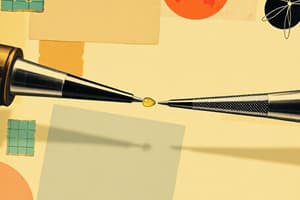Podcast
Questions and Answers
What is the primary function of a micropipette?
What is the primary function of a micropipette?
- To clean laboratory glassware
- To measure and transfer small volumes of liquids (correct)
- To mix chemicals in large containers
- To measure large volumes of liquids
A fixed volume micropipette allows you to adjust the volume setting.
A fixed volume micropipette allows you to adjust the volume setting.
False (B)
What part of the micropipette is pressed to aspirate liquid?
What part of the micropipette is pressed to aspirate liquid?
Plunger
The __________ button is used to expel the attached tip from a micropipette.
The __________ button is used to expel the attached tip from a micropipette.
Match the type of micropipette with its description:
Match the type of micropipette with its description:
Which volume range would be appropriate for a micropipette used to measure 0.5 µL?
Which volume range would be appropriate for a micropipette used to measure 0.5 µL?
To dispense liquid completely from a micropipette, you only need to press the plunger to the first stop.
To dispense liquid completely from a micropipette, you only need to press the plunger to the first stop.
What must you do before aspirating liquid with a micropipette?
What must you do before aspirating liquid with a micropipette?
What is the primary function of a spectrophotometer?
What is the primary function of a spectrophotometer?
Blood samples can only be collected from veins.
Blood samples can only be collected from veins.
List two components of a spectrophotometer.
List two components of a spectrophotometer.
The procedure of drawing blood and sampling requires proper __________.
The procedure of drawing blood and sampling requires proper __________.
Match the following equipment with their uses in blood sampling:
Match the following equipment with their uses in blood sampling:
What angle should the needle be inserted during blood collection?
What angle should the needle be inserted during blood collection?
It is acceptable to use the same alcohol swab to clean multiple sites.
It is acceptable to use the same alcohol swab to clean multiple sites.
What should be done after the blood collection tube is full?
What should be done after the blood collection tube is full?
What is the molecular formula for glucose?
What is the molecular formula for glucose?
Hypoglycemia is characterized by high blood sugar levels.
Hypoglycemia is characterized by high blood sugar levels.
The suffix ‘-ose’ in glucose denotes that it is a type of __________.
The suffix ‘-ose’ in glucose denotes that it is a type of __________.
List two common causes of hyperglycemia.
List two common causes of hyperglycemia.
Match the symptoms with the correct condition:
Match the symptoms with the correct condition:
Which type of diabetes is also known as insulin-dependent diabetes mellitus?
Which type of diabetes is also known as insulin-dependent diabetes mellitus?
The oral glucose tolerance test requires fasting for 8 hours before the test.
The oral glucose tolerance test requires fasting for 8 hours before the test.
What is hypoglycemia?
What is hypoglycemia?
What is the purpose of pressing the plunger down to the first stop when aspirating liquid?
What is the purpose of pressing the plunger down to the first stop when aspirating liquid?
It is acceptable to touch the tip of the pipette to surfaces while dispensing liquid.
It is acceptable to touch the tip of the pipette to surfaces while dispensing liquid.
What is the relationship between concentration and percent transmittance (% T) according to Beer’s law?
What is the relationship between concentration and percent transmittance (% T) according to Beer’s law?
The formula to calculate absorbance (A) is A = -log(% T), where % T represents the ______ of light transmitted.
The formula to calculate absorbance (A) is A = -log(% T), where % T represents the ______ of light transmitted.
Match the terms with their correct descriptions:
Match the terms with their correct descriptions:
Which components are needed to determine the concentration of a substance using the Beer-Lambert Law?
Which components are needed to determine the concentration of a substance using the Beer-Lambert Law?
If the intensity of transmitted light (It) increases, the absorbance (A) will also increase.
If the intensity of transmitted light (It) increases, the absorbance (A) will also increase.
What should you do with the pipette tip after dispensing the liquid?
What should you do with the pipette tip after dispensing the liquid?
What is the normal fasting blood glucose range (mg/dL)?
What is the normal fasting blood glucose range (mg/dL)?
Globulin is primarily made in the liver.
Globulin is primarily made in the liver.
What is the primary function of albumin in the blood?
What is the primary function of albumin in the blood?
High albumin levels may be caused by __________.
High albumin levels may be caused by __________.
Match the type of serum protein with its characteristic:
Match the type of serum protein with its characteristic:
What type of protein structure refers to the overall shape of a single protein molecule?
What type of protein structure refers to the overall shape of a single protein molecule?
Low levels of globulin may indicate kidney disease.
Low levels of globulin may indicate kidney disease.
Name one condition that could cause high globulin levels.
Name one condition that could cause high globulin levels.
Flashcards
Micropipette function
Micropipette function
A laboratory tool for accurately measuring and transferring small liquid volumes (typically in microliters).
Micropipette component: Plunger
Micropipette component: Plunger
The part of the micropipette you press to draw up (aspirate) and release (dispense) liquid.
Micropipette: Volume Adjustment
Micropipette: Volume Adjustment
Adjusts the amount of liquid drawn or dispensed using a dial or digital display.
Micropipette: Tip Ejector
Micropipette: Tip Ejector
Signup and view all the flashcards
Micropipette tip holder
Micropipette tip holder
Signup and view all the flashcards
Single-channel micropipette
Single-channel micropipette
Signup and view all the flashcards
Multi-channel micropipette
Multi-channel micropipette
Signup and view all the flashcards
Micropipette volume range
Micropipette volume range
Signup and view all the flashcards
Aspirating Liquid
Aspirating Liquid
Signup and view all the flashcards
Dispensing Liquid
Dispensing Liquid
Signup and view all the flashcards
Beer-Lambert Law
Beer-Lambert Law
Signup and view all the flashcards
Absorbance (A)
Absorbance (A)
Signup and view all the flashcards
Molar Absorptivity (a)
Molar Absorptivity (a)
Signup and view all the flashcards
Light Path (b)
Light Path (b)
Signup and view all the flashcards
Percent Transmittance (%T)
Percent Transmittance (%T)
Signup and view all the flashcards
Spectrophotometer
Spectrophotometer
Signup and view all the flashcards
Spectrophotometer use
Spectrophotometer use
Signup and view all the flashcards
Blood sample collection
Blood sample collection
Signup and view all the flashcards
Venipuncture steps
Venipuncture steps
Signup and view all the flashcards
Tourniquet use
Tourniquet use
Signup and view all the flashcards
Alcohol swab use
Alcohol swab use
Signup and view all the flashcards
Blood collection tube
Blood collection tube
Signup and view all the flashcards
Venipuncture site preparation
Venipuncture site preparation
Signup and view all the flashcards
Patient preparation for blood draw
Patient preparation for blood draw
Signup and view all the flashcards
Hypoglycemia
Hypoglycemia
Signup and view all the flashcards
Hyperglycemia
Hyperglycemia
Signup and view all the flashcards
Diabetes Mellitus
Diabetes Mellitus
Signup and view all the flashcards
Glucose
Glucose
Signup and view all the flashcards
Type 1 Diabetes
Type 1 Diabetes
Signup and view all the flashcards
Type 2 Diabetes
Type 2 Diabetes
Signup and view all the flashcards
Fasting Blood Glucose Test
Fasting Blood Glucose Test
Signup and view all the flashcards
Apply Pressure To Venipuncture Site
Apply Pressure To Venipuncture Site
Signup and view all the flashcards
Protein Structure
Protein Structure
Signup and view all the flashcards
Total Serum Protein
Total Serum Protein
Signup and view all the flashcards
Albumin
Albumin
Signup and view all the flashcards
Globulin
Globulin
Signup and view all the flashcards
Glucose Measurement
Glucose Measurement
Signup and view all the flashcards
Normal Fasting Glucose
Normal Fasting Glucose
Signup and view all the flashcards
High Albumin Causes
High Albumin Causes
Signup and view all the flashcards
Low Albumin Causes
Low Albumin Causes
Signup and view all the flashcards
Study Notes
Micropipettes
- Micropipettes are lab tools for measuring and transferring small liquid volumes (typically in microliters).
- Components and how they work:
- Plunger: The top part used for aspiration (drawing up) and dispensing (releasing).
- Volume Adjustment Dial: Allows setting the desired volume using a knob or digital display.
- Tip Ejector Button: Used for expelling the attached tip.
- Tip Holder: Holds the disposable tip.
- How Micropipettes Work:
- Set the desired volume.
- Attach the sterile tip.
- Aspirate: Press the plunger to the first stop, then slowly release to draw up the liquid.
- Dispense: Press the plunger to the first stop to expel the liquid, and to the second stop for complete dispensing.
- Eject the tip.
- Types of Micropipettes:
- Single-Channel: Used for transferring one sample at a time.
- Multi-Channel: Used for simultaneously transferring multiple samples (8, 12, or 16 channels).
- Variable Volume: Adjustable volume within a specific range.
- Fixed Volume: Has a set volume that cannot be changed.
How to Use a Micropipette
- Select the Correct Micropipette: Choose a micropipette with a volume range encompassing the required volume.
- Set the Desired Volume: Turn the plunger to adjust the volume; digital readouts or dials are used.
- Attach the Tip: Carefully insert the sterile tip into the tip holder.
Using a Micropipette (Procedure)
- Press the Tip Ejector: To create space for the tip.
- Insert the Tip: Carefully place the tip into the pipette shaft.
- Immerse the Tip: Submerge the tip into the correct liquid. Ensure the tip is below the surface of the liquid.
- Press the First Stop: Slowly press the plunger to the first stop. This creates a vacuum, drawing the liquid into the tip.
- Avoid Air Bubbles: Ensure no air bubbles are present in the tip; this can affect the accuracy of the volume measurements.
- Position Tip: Position the tip over the target location.
- Press the Second Stop: Slowly press the plunger to the second stop to expel the liquid from the tip.
- Avoid Touching Surfaces: Avoid causing liquid adherence to surfaces during dispensing.
Parts of Micropipette
- Ergonomic Finger Hook
- Push Button
- Tip Ejector
- Tip Ejector Collar
- Pipette Tip
- Volume Display
- Tip Cone
Beer's Law
- When light of a specific wavelength hits a cuvette containing a colored sample, some light is absorbed, and the rest is transmitted.
- % Transmittance = (Transmitted light intensity / Initial light intensity) x 100
- Absorbance = -log(% Transmittance)
- Beer's Law (A = a b c), states that the absorbance of a solution is directly proportional to the concentration of the dissolved substance.
Spectrophotometer
- A spectrophotometer is a device used to measure the light transmitted by a solution to determine the concentration of the light-absorbing substance in the solution.
- Components:
- Light Source
- Monochromators
- Sample Cell (Cuvette)
- Photodetectors
- Meter
Drawing Blood and Sampling
- Drawing blood and sampling involves proper training to avoid infections and tissue damage.
- Blood Samples: collected from capillaries, veins, or sometimes arteries.
- Equipment:
- Tourniquet
- Alcohol swabs,
- Gloves
- Needles,
- Blood collection tubes,
- Bandages
Glucose
- Glucose is a primary energy source for most living organisms.
- Glucose has a chemical formula of C₆H₁₂O₆.
- Hypoglycemia: Low blood sugar; causes include too much insulin, too much exercise and not enough food.
- Hyperglycemia: High blood sugar; causes include insufficient insulin intake, illness (like a cold), eating too much, or medications.
Diabetes Mellitus
- Diabetes mellitus is a group of metabolic diseases characterized by hyperglycemia.
- Types:
- Type 1 (insulin-dependent)
- Type 2 (non-insulin-dependent)
- Gestational diabetes
- Glucose Blood Tests:
- Fasting blood glucose
- Oral glucose tolerance test (OGTT)
- Random blood sugar
- Hemoglobin A1c (HbA1c)
Protein
- Proteins are large biological molecules, made of one or more amino acid chains.
- Functions include: catalyzing metabolic reactions, replicating DNA, transporting molecules, etc.
- Total Serum Protein Test: Measures the total amount and specific amounts of albumin and globulin.
- Albumin: Synthesized primarily in the liver; important for maintaining blood volume and transporting substances.
- Globulin: Made by the liver and immune system; some globulins bind with hemoglobin, others transport metals.
- Structure (4 levels):
- Primary (amino acid sequence)
- Secondary (hydrogen bond arrangements)
- Tertiary (overall 3D structure)
- Quaternary (multiple polypeptide chains connected)
- High protein values: May indicate conditions like dehydration.
- Low protein values: May indicate conditions like malnutrition, kidney disease, liver disease, or autoimmune disorders.
Studying That Suits You
Use AI to generate personalized quizzes and flashcards to suit your learning preferences.




